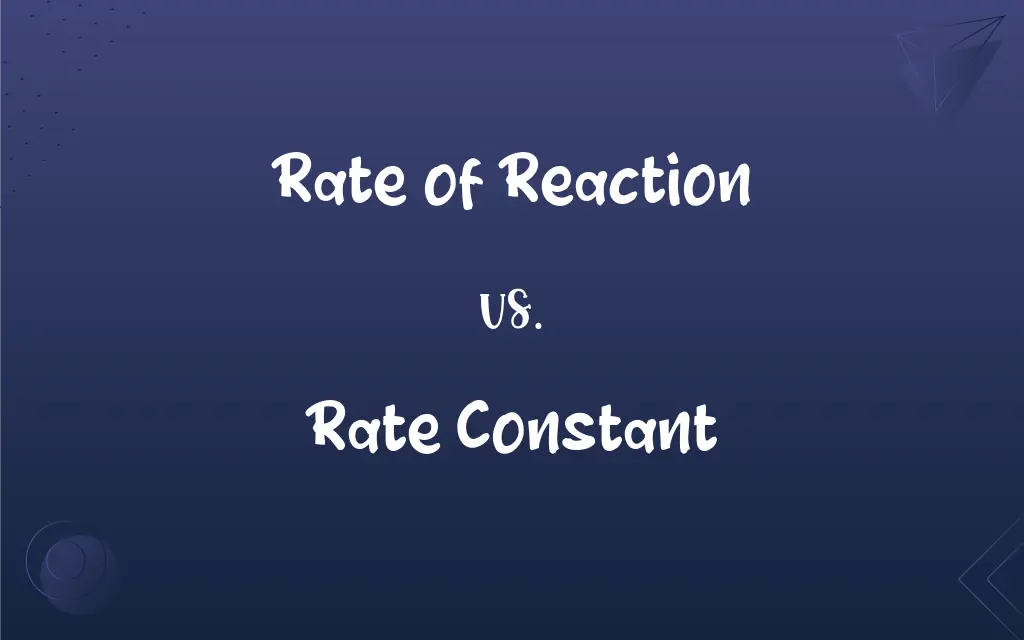Rate of Reaction vs. Rate Constant: What's the Difference?
Edited by Aimie Carlson || By Harlon Moss || Updated on October 25, 2023
The rate of reaction measures how fast a reaction proceeds, while the rate constant is a proportionality constant in the rate law relating reaction rate to reactant concentrations.

Key Differences
The rate of reaction describes the speed at which reactants are consumed or products are formed in a given reaction. The rate constant, on the other hand, is a specific number that relates the rate of a reaction to the concentration of its reactants for a given set of conditions.
While the rate of reaction can change depending on the amount of reactants and conditions like temperature or pressure, the rate constant remains the same for a specific reaction at a particular temperature. However, it's important to note that the rate constant may vary with temperature.
Rate of reaction often has units like moles per liter per second (mol/L·s), indicating the change in concentration over time. Conversely, the units of the rate constant vary depending on the reaction order, which is determined by the reaction's mechanism.
One can determine the rate of reaction experimentally by monitoring the concentration of reactants or products over time. The rate constant, however, often requires analysis of multiple reaction rates at different concentrations, typically derived from the slope of a plot when the rate law is applied.
Both rate of reaction and rate constant are fundamental in chemical kinetics. While the rate of reaction provides insight into the real-time progression of a reaction, the rate constant offers a more intrinsic property of the reaction under specific conditions, allowing for predictions and comparisons.
ADVERTISEMENT
Comparison Chart
Definition
Speed at which a reaction occurs.
Proportionality constant in the rate law.
Dependency
Varies with reactant concentration and conditions.
Remains constant at a specific temperature.
Units
Often in mol/L·s or similar.
Varies based on reaction order.
Determination
Monitored over time experimentally.
Derived from analyzing multiple reaction rates.
Role in Kinetics
Indicates real-time progression of a reaction.
Intrinsic property allowing for predictions.
ADVERTISEMENT
Rate of Reaction and Rate Constant Definitions
Rate of Reaction
Describes the efficiency of reactant consumption.
In the experiment, they aimed to optimize the rate of reaction.
Rate Constant
Essential in predicting reaction behavior.
Using the rate constant, they modeled the reaction's future behavior.
Rate of Reaction
Represents the dynamic progression of a reaction.
Graphing the data revealed the varying rate of reaction over time.
Rate Constant
A temperature-dependent constant for a specific reaction.
As the temperature changed, the rate constant also varied.
Rate of Reaction
The speed at which reactants turn into products.
The rate of reaction increased when the temperature was raised.
Rate Constant
Represents the intrinsic rate of a reaction.
Comparing the rate constant helps in understanding reaction efficiencies.
Rate of Reaction
Change in concentration of a substance over time.
By monitoring the reactant, they determined the rate of reaction.
Rate Constant
A proportionality factor in the rate law.
The rate constant for the reaction was determined to be 2.5 L/mol·s.
Rate of Reaction
A measure of how quickly a chemical reaction occurs.
With the addition of a catalyst, the rate of reaction was significantly enhanced.
Rate Constant
Independent of the concentration of reactants.
Even with different starting amounts, the rate constant remained the same.
FAQs
Can catalysts affect the rate of reaction?
Yes, catalysts can significantly increase the rate of reaction without being consumed.
How is the rate of reaction measured?
The rate of reaction is often measured by monitoring the change in concentration of reactants or products over time.
What does the rate of reaction tell us?
The rate of reaction indicates how quickly reactants are converted into products.
Is the rate constant always fixed for a reaction?
The rate constant is fixed for a reaction at a specific temperature but can change with temperature variations.
How can one experimentally determine the rate constant?
By performing reactions at different concentrations and plotting data based on the rate law, one can derive the rate constant.
Can the rate constant be negative?
No, the rate constant is always a positive value.
How does the rate constant relate to reaction mechanisms?
The rate constant, along with the rate law, can provide insights into the reaction mechanism and the steps involved.
Is the rate of reaction always constant throughout a reaction?
No, the rate of reaction can change as reactants are consumed and their concentrations decrease.
Can the rate of reaction be zero?
Yes, in some cases, if reactants are not available or conditions are not favorable, the rate can be zero.
Does increasing concentration always increase the rate of reaction?
Generally, increasing the concentration of reactants increases the rate of reaction, but the relationship is determined by the reaction order.
How is the order of a reaction linked to the rate constant's units?
The order of the reaction determines the units of the rate constant, ensuring dimensional consistency in the rate law.
Do reversible reactions have different rate constants for forward and reverse reactions?
Yes, reversible reactions have distinct rate constants for the forward and reverse processes.
Can we determine the rate constant from a single rate of reaction measurement?
Typically, multiple measurements at different concentrations are needed to determine the rate constant accurately.
Why do different reactions have different rate constants?
Different reactions have varying intrinsic speeds and mechanisms, leading to different rate constants.
Do all reactions have a rate constant?
Yes, every reaction has a specific rate constant for given conditions.
How does the rate law help in finding the rate constant?
The rate law relates the rate of reaction to reactant concentrations and the rate constant, enabling its determination.
Does a large rate constant mean a fast rate of reaction?
Not necessarily. While a large rate constant can indicate a fast intrinsic rate, the actual rate of reaction depends on reactant concentrations.
Does a higher rate of reaction mean a faster reaction?
Yes, a higher rate of reaction indicates a faster conversion of reactants to products.
What factors can affect the rate constant?
The rate constant primarily changes with temperature and can also be affected by the presence of a catalyst.
What units are commonly used for the rate of reaction?
Common units include mol/L·s or similar units indicating concentration change over time.
About Author
Written by
Harlon MossHarlon is a seasoned quality moderator and accomplished content writer for Difference Wiki. An alumnus of the prestigious University of California, he earned his degree in Computer Science. Leveraging his academic background, Harlon brings a meticulous and informed perspective to his work, ensuring content accuracy and excellence.
Edited by
Aimie CarlsonAimie Carlson, holding a master's degree in English literature, is a fervent English language enthusiast. She lends her writing talents to Difference Wiki, a prominent website that specializes in comparisons, offering readers insightful analyses that both captivate and inform.































































